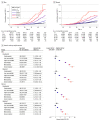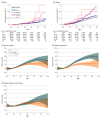Adolescent Body Mass Index and Early Chronic Kidney Disease in Young Adulthood
- PMID: 38079159
- PMCID: PMC10714283
- DOI: 10.1001/jamapediatrics.2023.5420
Adolescent Body Mass Index and Early Chronic Kidney Disease in Young Adulthood
Abstract
Importance: Despite increasing obesity rates in adolescents, data regarding early kidney sequelae are lacking.
Objective: To assess the association between adolescent body mass index (BMI) and early chronic kidney disease (CKD) in young adulthood (<45 years of age).
Design, setting, and participants: This cohort study linked screening data of mandatory medical assessments of Israeli adolescents to data from a CKD registry of a national health care system. Adolescents who were aged 16 to 20 years; born since January 1, 1975; medically evaluated for mandatory military service through December 31, 2019; and insured by Maccabi Healthcare Services were assessed. Individuals with kidney pathology, albuminuria, hypertension, dysglycemia, or missing blood pressure or BMI data were excluded. Body mass index was calculated as weight in kilograms divided by height in meters squared and categorized by age- and sex-matched percentiles according to the US Centers for Disease Control and Prevention. Follow-up started at the time of medical evaluation or January 1, 2000 (whichever came last), and ended at early CKD onset, death, the last day insured, or August 23, 2020 (whichever came first). Data analysis was performed from December 19, 2021, to September 11, 2023.
Main outcomes and measures: Early CKD, defined as stage 1 to 2 CKD by moderately or severely increased albuminuria, with an estimated glomerular filtration rate of 60 mL/min/1.73 m2 or higher.
Results: Of 629 168 adolescents evaluated, 593 660 (mean [SD] age at study entry, 17.2 [0.5] years; 323 293 [54.5%] male, 270 367 [45.5%] female) were included in the analysis. During a mean (SD) follow-up of 13.4 (5.5) years for males and 13.4 (5.6) years for females, 1963 adolescents (0.3%) developed early CKD. Among males, the adjusted hazard ratios were 1.8 (95% CI, 1.5-2.2) for adolescents with high-normal BMI, 4.0 (95% CI, 3.3-5.0) for those with overweight, 6.7 (95% CI, 5.4-8.4) for those with mild obesity, and 9.4 (95% CI, 6.6-13.5) for those with severe obesity. Among females, the hazard ratios were 1.4 (95% CI, 1.2-1.6) for those with high-normal BMI, 2.3 (95% CI, 1.9-2.8) for those with overweight, 2.7 (95% CI, 2.1-3.6) for those with mild obesity, and 4.3 (95% CI, 2.8-6.5) for those with severe obesity. The results were similar when the cohort was limited to individuals who were seemingly healthy as adolescents, individuals surveyed up to 30 years of age, or those free of diabetes and hypertension at the end of the follow-up.
Conclusions and relevance: In this cohort study, high BMI in late adolescence was associated with early CKD in young adulthood. The risk was also present in seemingly healthy individuals with high-normal BMI and before 30 years of age, and a greater risk was seen among those with severe obesity. These findings underscore the importance of mitigating adolescent obesity rates and managing risk factors for kidney disease in adolescents with high BMI.
Conflict of interest statement
Figures




References
-
- Kelly AS, Barlow SE, Rao G, et al. ; American Heart Association Atherosclerosis, Hypertension, and Obesity in the Young Committee of the Council on Cardiovascular Disease in the Young, Council on Nutrition, Physical Activity and Metabolism, and Council on Clinical Cardiology . Severe obesity in children and adolescents: identification, associated health risks, and treatment approaches: a scientific statement from the American Heart Association. Circulation. 2013;128(15):1689-1712. doi:10.1161/CIR.0b013e3182a5cfb3 - DOI - PubMed
Publication types
MeSH terms
LinkOut - more resources
Full Text Sources
Medical

